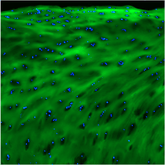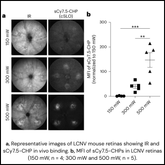Accumulation of collagen molecular unfolding is the mechanism of cyclic fatigue damage and failure in collagenous tissues
A very interesting article recently published in Science Advances utilized CHPs in a very specific and unique way. Jeff Weiss's group from the University of Utah used CHPs to evaluate how micro-damage in tendons accumulates and leads to tissue failure in tendons. They used finite-element simulations, molecular dynamic simulations, and CHP staining to show how the relationship between creep, mechanical strain, strain rate, and the collagen triple-helix structure all influence tendon fatigue and, ultimately, their failure. They showed that the mechanical unfolding of the collagen triple helix is a critical feature of tendon fatigue damage. This is a very well written article that explains the current hypotheses in this field as well as the limit of their study. Great read! We highly recommend it!
Abstract
Overuse injuries to dense collagenous tissues are common, but their etiology is poorly understood. The predominant hypothesis that micro-damage accumulation exceeds the rate of biological repair is missing a mechanistic explanation. Here, we used collagen hybridizing peptides to measure collagen molecular damage during tendon cyclic fatigue loading and computational simulations to identify potential explanations for our findings. Our results revealed that triple-helical collagen denaturation accumulates with increasing cycles of fatigue loading, and damage is correlated with creep strain independent of the cyclic strain rate. Finite-element simulations demonstrated that biphasic fluid flow is a possible fascicle-level mechanism to explain the rate dependence of the number of cycles and time to failure. Molecular dynamics simulations demonstrated that triple-helical unfolding is rate dependent, revealing rate-dependent mechanisms at multiple length scales in the tissue. The accumulation of collagen molecular denaturation during cyclic loading provides a long-sought “micro-damage” mechanism for the development of overuse injuries.
CHECK OUT THE FULL ARTICLE HERE





























